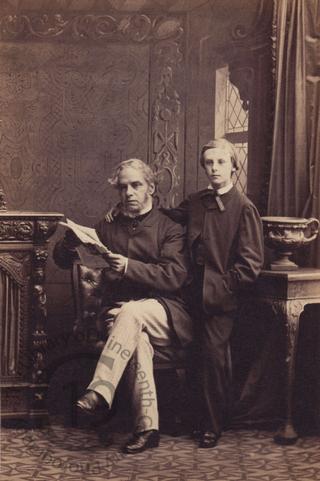
John Edward Lee and Edward Arthur Lee
A carte-de-visite portrait of the ironmaster and antiquarian John Edward Lee (1808-1887), seen here with his son Edward Arthur Lee (1851-1921).
John Edward Lee was born on 21 December 1808 at Newland, a small hamlet near Cottingham in Yorkshire. He developed an early interest in science, beginning with entomology but soon broadening his attentions to include geology, archaeology and all aspects of natural history. His father died when he was still very young and he was brought up by two uncles, Avison and John Terry. At sixteen he entered their shipping office in Hull, where he took an active part in the town’s Royal Institution. Suffering from ill-health, he travelled abroad, first in Norway and Sweden, then afterwards in Russia and other parts of the continent. During these tours he sketched and mastered both French and German thoroughly.
In 1841 he settled in South Wales, where he became a partner in the iron works of J.J. Cordes and Co. of Newport, manufacturers of nails and rivets. He lived at The Priory in the small town of Caerleon, where he set about recording the many Roman antiquities which were surfacing in the area. In 1845 he published a book of drawings entitled Delineations of Roman Antiquities Found at Caerleon (the Ancient Isca Silurum) and the Neighbourhood.
When two excavations in 1847 unearthed a Roman burial site and a large bathhouse, several of the town’s residence formed the Caerleon Antiquarian Association with the aim of preserving Caerleon’s heritage through the establishment of a local museum. The inaugural meeting was held in Lee’s house on 28 October 1847 and the museum was opened in 1850. By 1862 it housed a large collection of Roman artefacts and geological specimens, mostly assembled and catalogued by Lee himself. In that year Lee published his greatest work to favourable reviews in the archaeological journals. Titled Isca Silurum, it was a meticulous catalogue of the museum’s holdings with 52 plates of illustrations, most of them drawn by Lee himself.
For the sake of his wife’s health, Lee moved from Caerleon to the Villa Syracusa (today the Headland Hotel) at Torquay in Devon in 1868. He died there on 18 August 1887, having two years previously donated his collection of 21,000 fossils to the British Museum. He left a personal estate valued at over £159,000.
His son Edward Arthur Lee was educated at Emmanuel College, Cambridge. Like his father, he became an ironmaster while also serving as a JP for Monmouthshire and Hampshire. He married Lucy Florence Maconchy at Torquay on 15 June 1876 and had three sons. He died on 27 February 1921 at Bath in Somerset, aged 69.
Photographed by Camille Silvy of London.
Code: 126013




